ANT-40RT (1934)
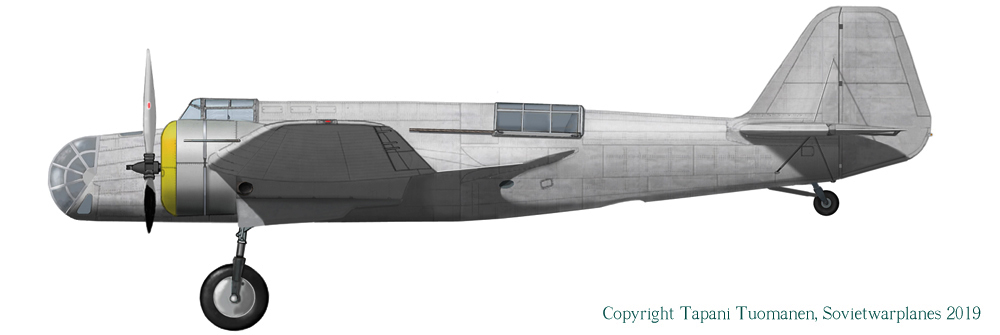
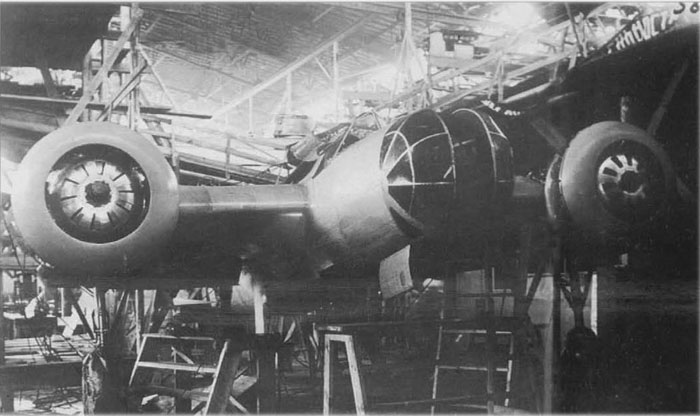
The construction of the radial engined ANT-40RT ('Rayt-Tsiklon', Wright Cyclone). began on 25th April 1934.
Left:
photo of the first prototype in factory, about two months before its first flight.
The anodized duraluminum surface is recognizable; the frontal cowling rings were painted in some color, hypothetically yellow.
Image from: SB bomber, M.Maslov, Ikarus Aviation Press
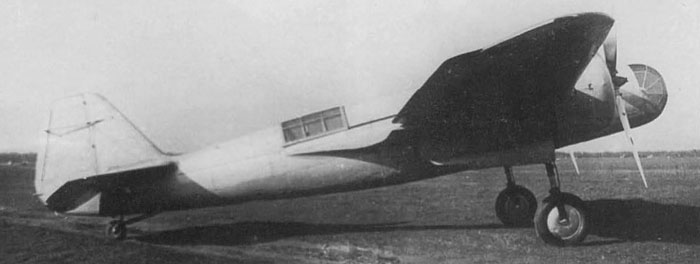


On 7th October 1934 test pilot K. K. Popov made the first flight of the ANT-40 RT.
On 31 October, at its ninth flight, the plane had an accident due to the rupture of an engine control rod and was returned to the factory to be repaired.
The first photo (and probably the other ones) was taken on 31 October 1934, the same day of the accident.
The main visual differences between this plane and the following production ones were:
- the radial engines and their propellers;
- the different fin and rudder, more angular, without compensation, with a very wide trim tab and the control rod on the right side;
- the wingspan was 19 m only, with a wing area of 46.3 sqm, against 20.3 m and 51.95 sqm of all the following planes;
- the outer panels of the wings had a sweep angle of only 4.5° instead of 9°;
- the rivet heads were flushed, a characteristic that was lost on production planes for industrial reasons;
- the thinner wheels of the main landing gear;
- a strut or fasterner in front of the tail wheel.
Note the shape of the stabilizer and rudder, thinner than the one of the successive production planes and with a very large trim tab.
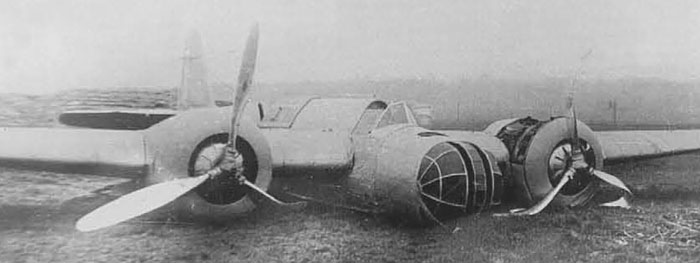
The plane after the forced landing of 31 October 1934. Popov had to shut down the engines that had problems, and belly land near the Central Moscow Airport.
Repair works lasted up to February 1935.

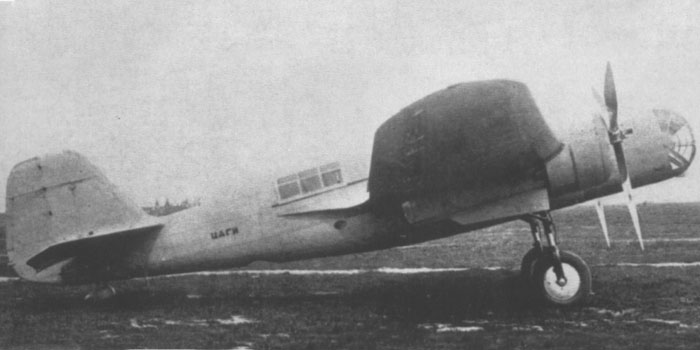
The prototype in 1935, after some modifications:
- the stabilizer and the rear part of the fuselage were extended rearwards, moving back the hinge line by much, while the leading edge looks preserved;
- a new rudder, shorter, less inclined and more rounded, limited the increase of length to few centimeters;
- the propellers were Hamilton, but with variable pitch and not pointed muzzle; the tips of the blades were more pointed, while the muzzle was no longer pointed;
- a new tail wheel, more robust, was installed; the brace in front of it was deleted; a drop-shaped fairing was installed on the tail wheel;
- the ventral hatch was enlarged, resulting clearly visible in photos;
- the inscription TsAGI, probably in black, can be read on the sides of the fuselage.
- three circular vents were opened on the low part of the front of each cowling (but it isn't clear if this was already made when the photos aside were shot);
- according to some sources, at some date the engines were replaced with double-row M-87s, but the cowling shown in the photos is too short to contain these engines, perhaps this was made in a later date.

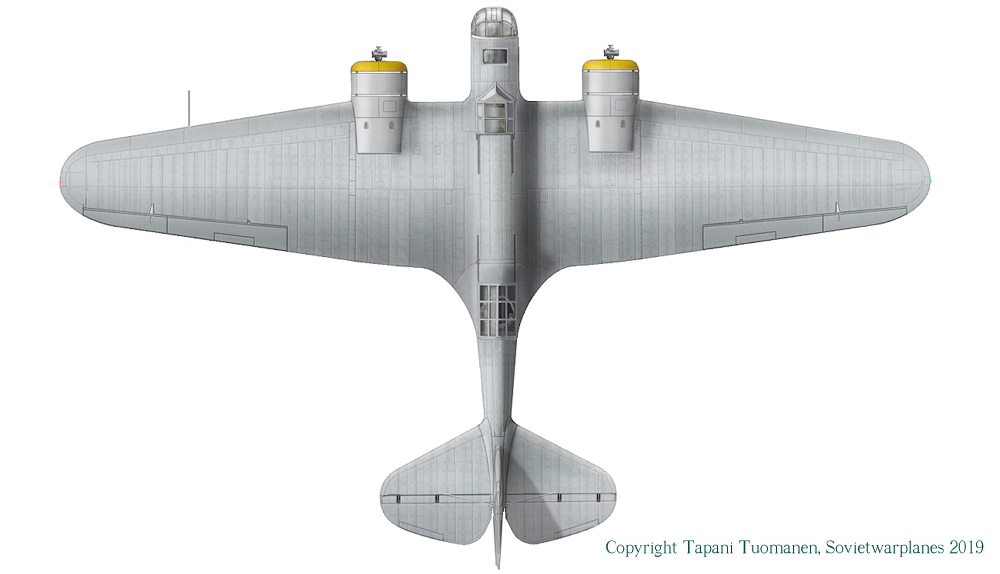
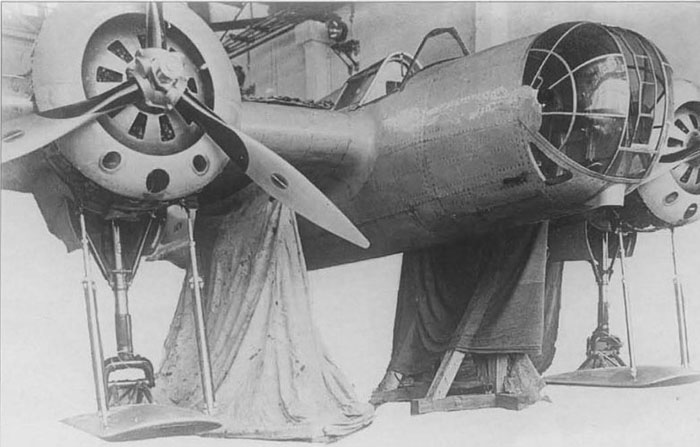
The prototype was first tested with a fixed ski gear for winter operations, but this device caused too much drag and loss of speed.
In 1936, the prototype was utilized to test a new retractable ski landing gear, visible on the photo.
Here we see the intake vents opened on the front of the cowling, and the different propellers.
Here the plane seems to have preserved its natural metal finish with (yellow?) painted front of engine cowlings.
ANT-40IS (early 1935)

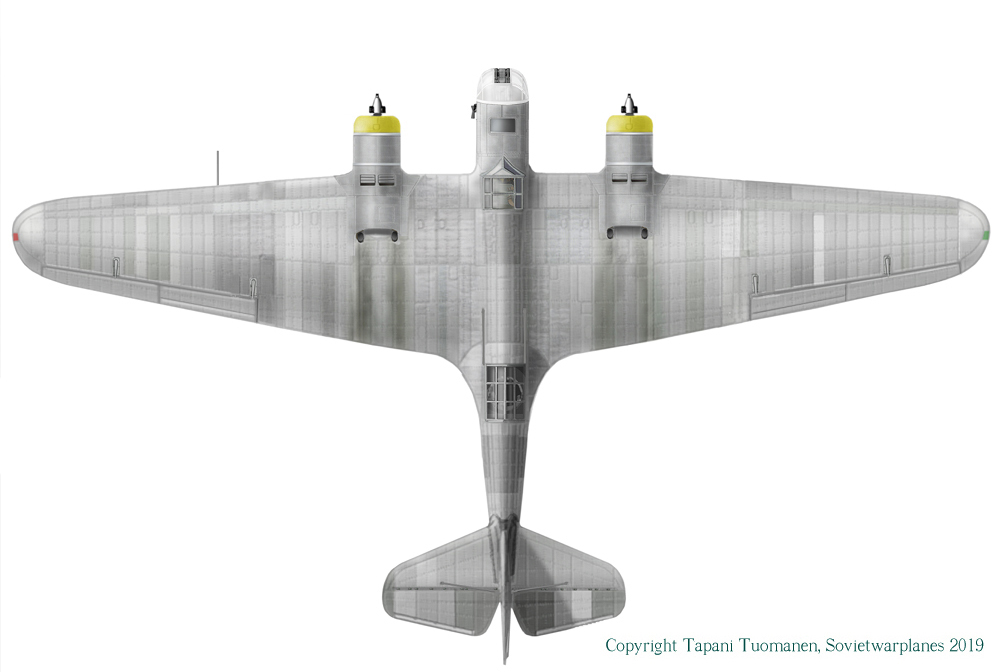
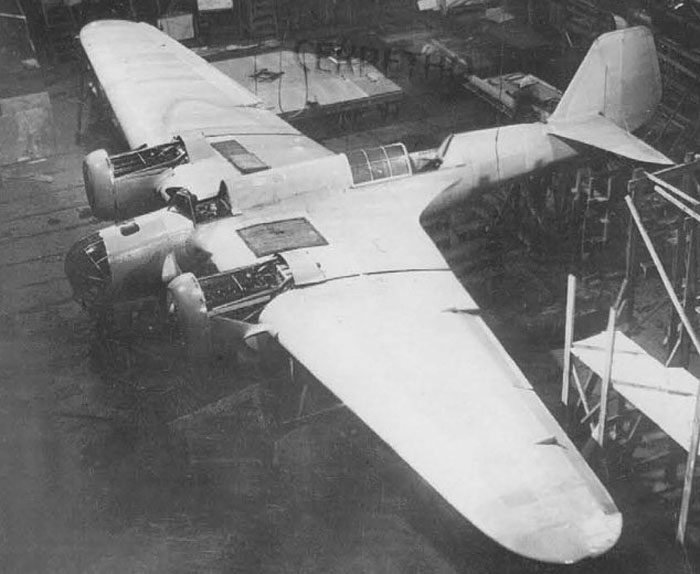
The second prototype of ANT-40, being powered by two in-line liquid-cooled 750 hp Hispano-Suiza engines was called ANT-40 IS (for 'Ispano-Sooiza').
The plane was started on 15th May in TsAGI's Factory of Experimental Designs (ZOK).
Being the in-line engines larger than the radials of the ANT-40RT, this prototype received a wider wing with a span of 20.3 m and an area of 51.95 sqm (just as the following production planes), and, in a first time, a sweep angle of only 4.5°( instead of 9° as on production planes)
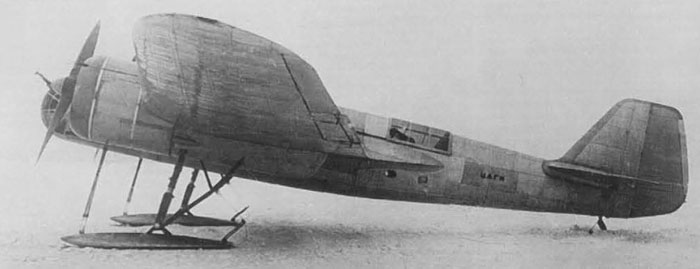

By 30th December the aircraft was ready and was flown that same day by I. S. Zhorov.
Manufacturer's tests lasted until 21st January 1935. A top speed of 430 km/h at 4,000 m was recorded, which significantly exceeded the requirements.
The first stage of State tests was completed on 20 February 1935.
The plane was equipped with non-retractable ski gear with limiter cables, rubber shock adsorber and covers instead of the doors of the bays. The tail wheel was replaced by a ski too.
The plane had wooden two-blades propellers, as those subsequently seen on the ANT-46 fighter version prototype.
Note that the defensive armament was already installed at the date of the photo,
The plane showed an unpainted anodized duraluminum finish; the front of the cowling seems painted in an unidentified color, possibly yellow. The inscription TsAGI on the fuselage is readable on the photo.
State trials of the second prototype were held between 8th February and 3rd March 1935, but were interrupted by aileron flutter. This was corrected within few days by fixing counter-balance weights on the ailerons.

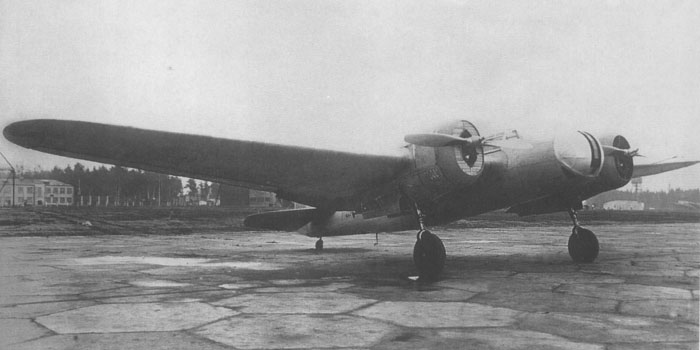
The state trials were resumed in the summer of 1935 and completed in April 1936.
The photo, taken in Shchelkovo airport, shows that it was equipped with two-blades fixed pitch propellers instead of the wooden ones; the fixed ski gear was removed and the plane had the wheels on its retractable gear.
The nose glazing seems to have been painted with white paint; only few parts seem still trasparent or opened.
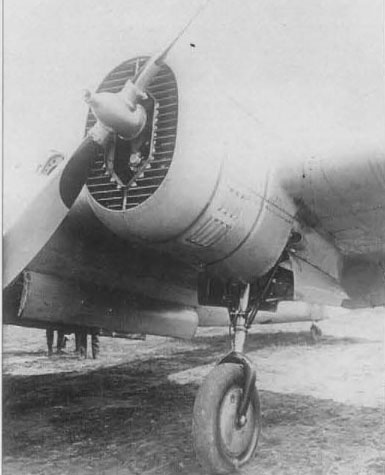
A detail of the frontal coolers on the Hispano-Suiza engines.
When compared to production planes, the coolers of the prototype had horizontal shutters instead of vertical ones; besides we see an hexagonal opening around the propeller's hub, probably to give better access to the gear for maintenance.
Besides the nacelles of this prototype were 100 mm shorter, had slots that were suppressed on production planes, and the wheels were narrower.
ANT-40 IS 2 (early 1936)

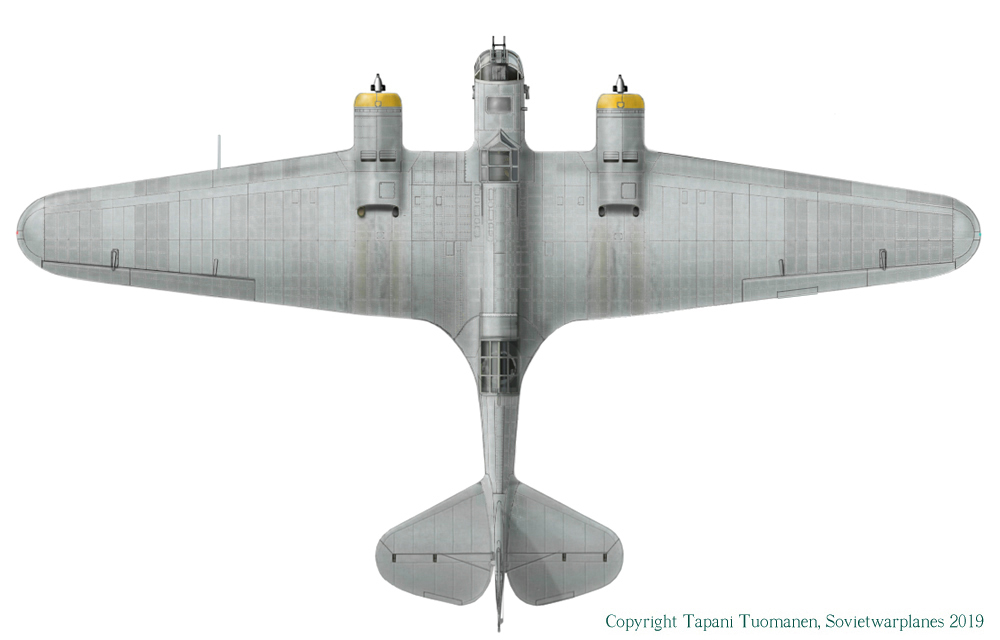



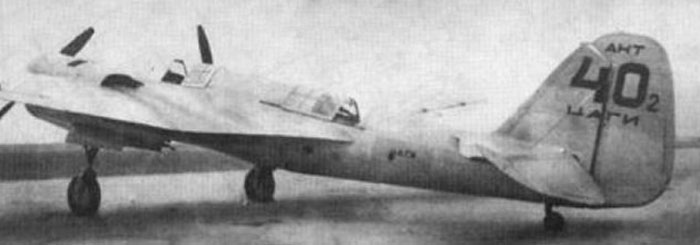
The second prototype was heavily modified and tested again at the beginning of 1936:
- its Hispano-Suiza engines were moved forward of 100 mm;
- the cooling shutters were made vertical, with a rectangular window around the propeller's hub;
- the sweep angle was increased from 4.5° to 9 °, with a new NACA-230 wing profile,
- a trim tab was added to the right wing aileron.
- the tail unit was enlarged and equipped with aerodynamic horn balances both on horizontal and vertical surfaces; the control rod of the rudder was still on the right side;
The plane was easily recognizable for the black inscription ANT 40 2 TsAGI on its tail; as before, it showed unpainted anodized duraluminum on its skinning. It is not clear from photos if the painted (yellow?) front of the cowlings was preserved.
Maslov hypothized that this could even be a third prototype, but there are not official documents to prove this.
The plane was tested with a fixed ski gear, with the bays closed; the black thing visible on the photo from the rear is the outlet of the open outlet of the cooler.
After this, the plane was sent to production Factory No.22 as a standard for the production series (dooblyor).
State trials of the first five experimental series examples took place between 25th March and 31st July 1936 and the aircraft was accepted for service.
The aerodynamic balance horns on the elevators were not preserved on production planes, and the rivets were no longer flush for industrial reasons.
Mass production of the SB began at Factory No.22 in 1936, and at Factory No.125 in Irkutsk in 1937.
ANT-46 (DI-8) Late 1935
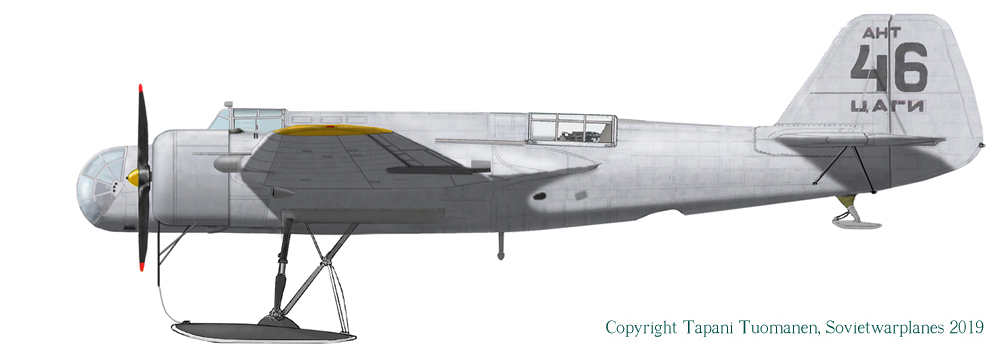
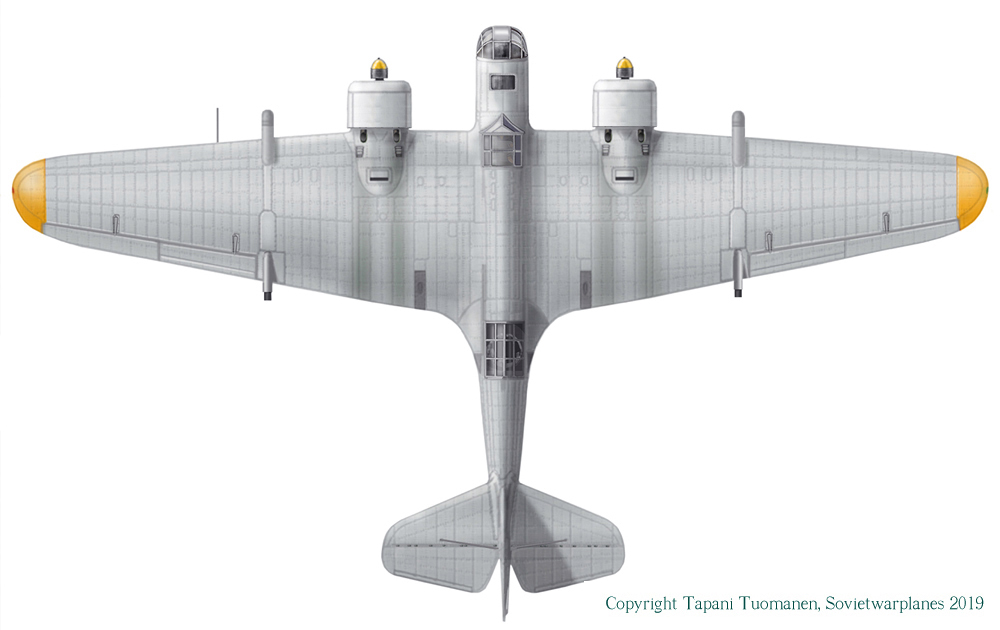
A long range fighter derivative, the ANT-46 or DI-8, was tested in November 1935. The plane was similar to the ANT-40, but powered with 800 hp Gnome-Rhone Mistral Major (or 14 Kdrs), radials with wooden two-blade propellers.
The plane was heavily armed with two 76 mm APK-4 recoilless guns installed on the outer wing panels. A fixed rearward-firing ShKAS was installed in the inner part of each wing; their fire was controlled from the gunner's cockpit, aside the usual defensive armament of ANT-40.
In November 1934 the fighter receiving the OKB designation ANT-46 and the official designation DI-8. The new machine was a long-range three-seat fighter version of the ANT-40 with a powerful offensive and defensive armament.
The nose gunner manned a 12.7-mm ShVAK machine-gun and the rear gunner had the same armament as on the SB.
The prototype was built in the summer of 1935, M. Yu. Alekseyev making the first flight on 1st August.

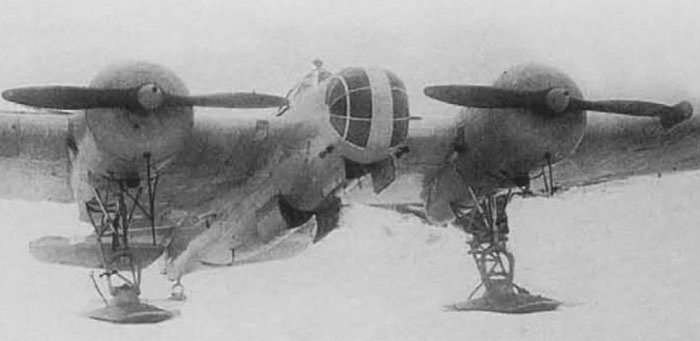
The plane photographed in winter 1935-1936 shows the front with 7 individual cooling hatches, closable with shutters (more or less as on I-16s) and wooden two-blades propellers. The photo shows an intake for the carburettors under the cowling, and sorts of intakes on the nacelle sides, perhaps for the oil cooler. The exhaust pipes probably were on the back, as visible on the photo of the later configuration.
The slot for the 12,7 machine gun for the navigator is closed by a curved plate.
A non-retractable ski gear was installed for winter tests. A strange strut, perhaps related to this, protrudes under the engine cowlings (on one side, it looks partially deleted because of a defect of the photo).
Some device, perhaps a gun camera, is mounted over the strut of the windshield.
Under the wingroot, we see a small rectangular window resembling a landing light, althoug in an unusual position.
The ventral bay is shorter than on SB.
The recoilless guns on the wings are covered.
Note the thing, probable the mast for a wire aerial, protruding under the fuselage.
Two Venturi probes are protruding aside the nose.
ANT-46 (DI-8) later configuration
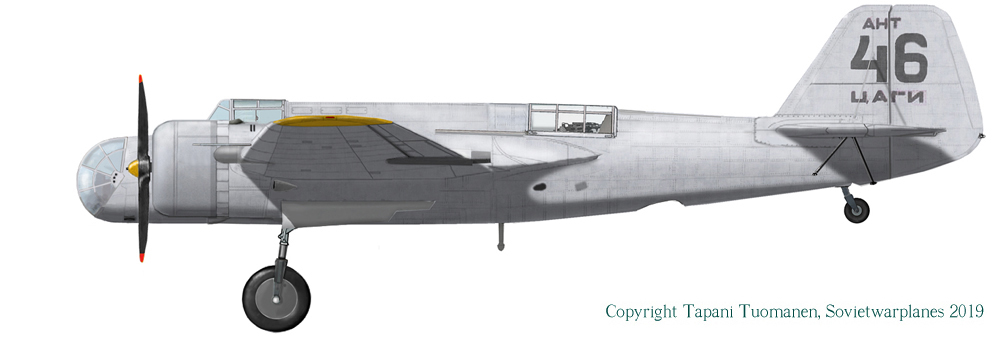
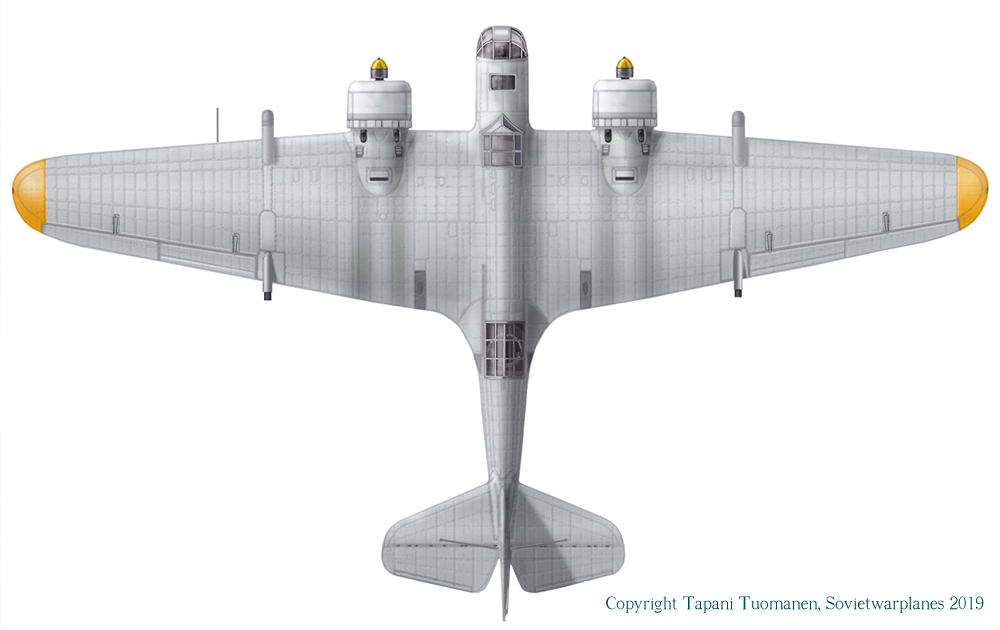

ANT-46 with a wheels landing gear, probably photographed in a later date.
The engine cowlings have been replaced with a NACA type with outlet flaps. The only existing photo looks conflicting with existing drawings from Russian books that show spaced windows followed by a band that could be an exposed exhaust collector behind them; the photo, instead, seems to show simple shutters behind a slightly darker ring that could be a simple metal nail; two exhaust pipes seem to brotrude from under these flaps. The intake under the cowling and the lateral intakes on the nacelles are supposed to be as on the early configuration. In absence of other data, the propeller is supposed to be the same of the earlier configuration.
It is unclear if the previded 12.7 mm ShVAK machine gun was installed on this stage, or if the nose is still closed by a curved metal plate as before.
The inscription ANT 46 TsAGI in black is visible on the tail, while the plane was probably finished in unpainted duraluminum; the wing tips look painted (yellow?).
The outlet for the recoilless guns and the fixed ShKAS are visible on the wing edges, while the gun camera on the windshield is no longer visible.
Factory tests continued until June 1936, revealing inadequate stability; to rectify this, new outer wing panels and tail as those of the ANT-40 IS 2 were previded, but it isn't clear if this thing was really made.
It was considered to replace the radials with Mikulin AM-34RN engines, but it is unlikely that this was really done.
The cancellation of further work on the recoilless cannons necessitated changes to the main armament. It was considered to replace them both with 2 ShVAK 20 mm guns in each wing, or with a gun pack of 5 ShVAK in a dismountable pack under the bombs bay (that could turn a standard SB bomber into an heavy fighter).
The interest was lost soon, and the ANT-46 was never presented to state tests.
In 1937 A.N. Tupolev was arrested, so the use of his initials was forbidden and the planes were called TsAGI-40 and 46.